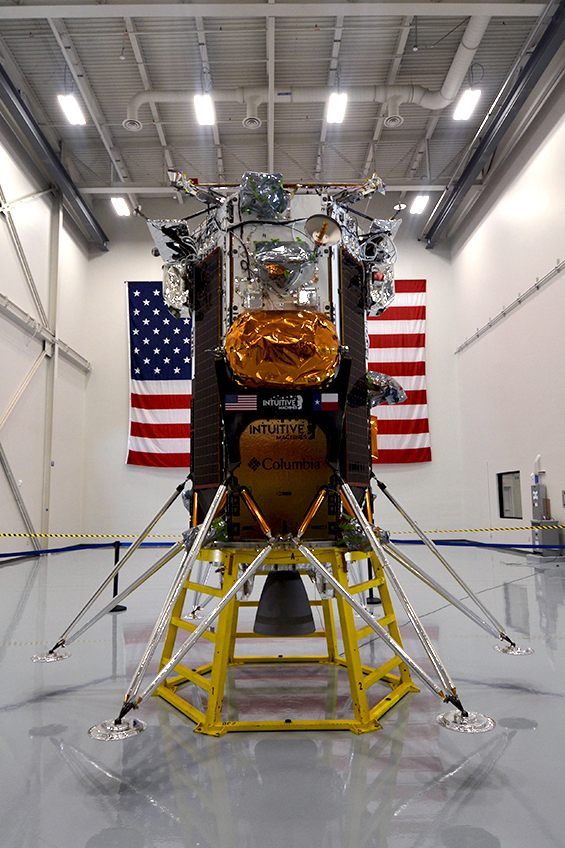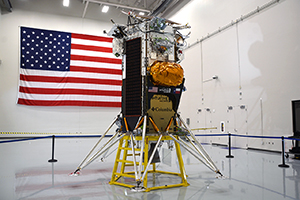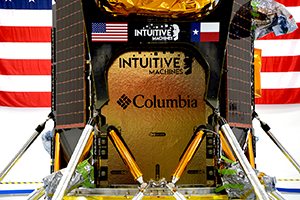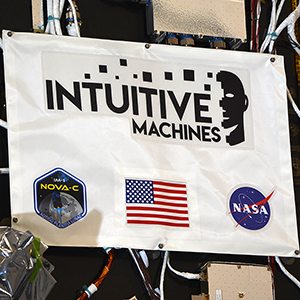October 3, 2023 — The first lunar lander to be built in Houston is ready to leave Space City for the moon.
Intuitive Machines on Tuesday (Oct. 2) provided a last close-up look at its Nova-C robotic lander before packing it up to move to Florida in preparation for its launch. The spacecraft may become the first U.S.-built vehicle to achieve a soft landing on the moon since NASA's Apollo 17 astronauts touched down in December 1972.
"I would like to be first. I hope it works out that way. It looks like it might and so good for us," said Steve Altemus, Intuitive Machines' CEO, during a media day at the company's newly-opened Lunar Production and Operations Center located at the Houston Spaceport (a part of Ellington Field). "But every step we move closer to shipping this to the Cape, integrating it with the launch vehicle, loading it with cryogenics, lifting off the pad, flying in the vicinity of the moon, capturing an orbit — every one of those is a success in its own right and I'd celebrate each one."
"We land softly, that's a touchdown. That's a wild success. 100% A+. If we don't, we've learned along the way, we'll pick ourselves up and go to the next," Altemus said an interview with collectSPACE.
Intuitive Machines' IM-1 mission will carry NASA instruments and commercial payloads bound for the south polar region on the near side of the moon under a contract with NASA's Commercial Lunar Payload Services (CLPS) program. The Nova-C lander is set to launch on a SpaceX Falcon 9 rocket as soon as Nov. 16, for a landing on the moon six days later.
"So 'Nova' is bright star in the sky, a bright new emerging star and [this is] a brand new lander flying to the moon," said Altemus, explaining the spacecraft's name. "'C' is the Roman numeral for 100. What we initially said was, 'let's build a lander that can carry 100 kilograms of payload to the surface.' So C is the 100 kilogram class."
The 14-foot-tall (4.3-meter), six-legged Nova-C lander measures 5 feet (1.6 m) across its hexagonal-shaped hull and weighs 1,488 pounds (675 kilograms). It is powered by a liquid methane and liquid oxygen-fed main engine, called the VR900, which was based on the vertical landing development work done by the Project Morpheus team at NASA's Johnson Space Center from 2010 to 2014.
Shielding Nova-C's cryogenic propulsion tank is a closeout panel covered in the same thermal reflective technology that is found in consumer outerwear, protecting the Nova-C lunar lander from the extreme temperatures of outer space. Columbia Sportswear of Portland, Oregon, originally based its Omni-Heat Infinity technology on the insulation blankets that protected the Apollo spacecraft, bringing its use full circle, from Earth to the moon and back in just over half a century.
"Once they described what they were doing, and I described to them what we had in our line already for some thermal reflective insulation, we realized our material could perhaps provide a benefit to the lunar lander, itself," said Haskell Beckham, Columbia's vice president of innovation. "As it turned out, the material that we use to line our jackets is exactly the same material that Intuitive Machines used."
Among the NASA-sponsored payloads flying on the IM-1 mission are a radio receiver system to measure the plasma environment that will be encountered by future Artemis astronauts, as well as provide a baseline for radio astronomy systems; a collection of laser retro-reflectors, similar to the type left by the Apollo astronauts to measure precise distances; and a LIDAR-based (Light Detection and Ranging) sensor that will provide velocity and range sensing during the descent.
NASA is also flying video and still image cameras to capture and analyze the effects of the lander's plume as it interacts with the lunar surface and a CubeSat-sized S-band beacon to demonstrate autonomous spacecraft positioning.
As a commercial spacecraft, Nova-C is also carrying EagleCam, a camera system designed at Embry-Riddle Aeronautical University in Florida to capture the first-ever, third-person picture of a spacecraft making a landing on a celestial body other than Earth. EagleCam will also test an electrostatic dust-removal system that could lead to future advances in spacesuit technology.
ILOA Hawai'i is flying ILO-X, a miniaturized dual-camera lunar imaging suite aimed at capturing some of the first images of the center of the Milky Way from the surface of the moon. Lonestar Data Holdings will demonstrate storing customers' documents aboard the Nova-C lander and the ability to both upload and download documents to and from Earth and the moon.
Galactic Legacy Labs' Lunaprise will archive "The Humanity Hall of Fame," holding messages on NanoFiche discs to show future civilizations how we lived and loved. Lastly, noted artist Jeff Koons is sending 125 miniature moons as a part of an NFT project, titled "Jeff Koons: Moon Phases."
Under development and construction in Houston since 2019 (when the launch was originally targeted for 2021), Intuitive Machines' Nova-C lander has competition for becoming the first vehicle to return the U.S. to the lunar surface. Pittsburgh-based Astrobotics is also preparing its Peregrine lander for launch on the first flight of United Launch Alliance's Vulcan rocket in the fourth quarter of this year. Which of the landers will launch first relies on a number of factors, including launch window availability and each of the spacecraft's final flight preparations in Florida.
"It's mostly integration," said Jack Fischer, vice president for operations at Intuitive Machines and a former NASA astronaut, referring to the work left to be done in Florida. "We take the legs off to ship and once we get down there we have some testing to make sure nothing happened in transport, but then it's mostly integration with the rocket."
"Thirty-five (35) days is is the timeframe that SpaceX wants for you to ship down to the Cape and we have quite a bit of margin in that," said Fischer." So, it's really not much work." |
|

Intuitive Machines' first Nova-C lunar lander stands complete in the company's Lunar Production and Operations Center in Houston on Tuesday, Oct. 3, 2023. (collectSPACE)

Intuitive Machines' IM-1 Nova-C lunar lander will carry payloads for NASA and commercial partners. All of the instruments are mounted on the exterior of the spacecraft. (collectSPACE)

The access panel covering the Nova-C lander's cryogenic tank is thermally shielded using Columbia Sportswear's Omni-Heat Infinity technology, the same material used to insulate their jackets and other apparel. (collectSPACE)

A U.S. flag mounted to a Beta cloth sign on Intuitive Machines' Nova-C lander is bound for the moon after having originally been slated to fly on a canceled Apollo mission. (collectSPACE) |
